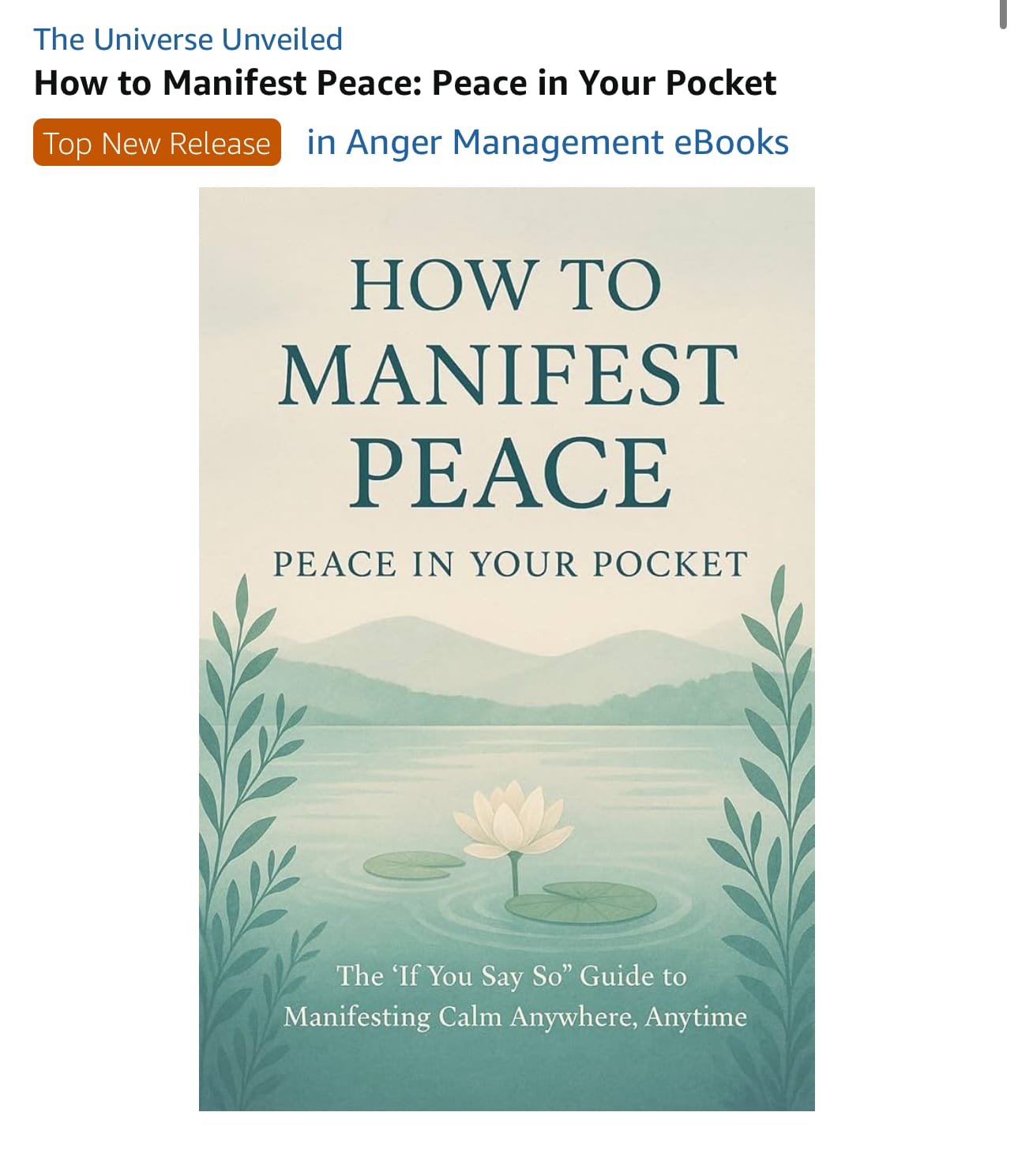🌿How to Manifest Peace with Three Words
Discover a simple 3-word practice to guard your energy, set boundaries, and choose calm—anytime, anywhere.

Whatever peace you are seeking—whether it’s in your mind, your relationships, or your daily life—it has to begin with you.
Peace isn’t something you wait for—it’s something you create in this very moment. But first, you must know how. Keep reading, because the change you’ve been longing for is about to reveal itself
Do not let doubt get in your way—you can manifest peace, and you have been led here for a reason.
At The Universe Unveiled, we fuse ancient wisdom, modern mind science, and practical manifestation into simple tools you can use in real life. And now, for the first time, we’ve distilled one of the most powerful of those tools into a single, life-changing guide. Inside, you’ll discover a deceptively simple three-word practice that protects your energy, clears the mental clutter, and brings you back to calm—anytime, anywhere. These words have helped readers dissolve conflict, quiet anxiety, and shift their state in seconds.
Manifest Peace Today. Get the book and start to practice.
Carry Unshakable Calm in Your Pocket—Anytime, Anywhere
If you’re tired of being yanked around by other people’s moods, the news cycle, or your own racing thoughts, keep reading.
Imagine walking through the same life—but with a different nervous system.
No spirals. No overreactions. No replaying the argument at 2 a.m.
Just a quiet, steady center you can return to in seconds.
That’s the promise of How to Manifest Peace: Peace in Your Pocket—a #1 Amazon best-seller that gives you a deceptively simple, three-word method to protect your energy, rewire your mind, and live with unshakable calm.
📖 Get Your Copy Now — Carry Peace With You
You came here looking for peace, this book will change your life.
📣 We Hit #1 — And It’s Just the Beginning
How to Manifest Peace has officially reached #1 in its category on Amazon — proof that people everywhere are ready to choose calm over chaos. This isn’t just a book… it’s a movement.
If you’ve ever wished for the kind of unshakable peace that stays with you through life’s storms, this is your sign. Inside, you’ll discover the deceptively simple 3-word technique that protects your energy, rewires your thoughts, and helps you manifest calm no matter what’s happening around you.

If your mind feels noisy and your heart restless, it’s time to discover How to Manifest Peace. Inside this book, I share the simple three-word method that silences inner chaos and aligns you with calm, clarity, and flow. Don’t wait for peace to find you—claim it now and start living from serenity
✨ Why Most “Peace” Advice Fails (and Why This Works)
A lot of guidance on peace is either too fluffy to use or too complicated to keep. You don’t need a 90-minute morning routine or a mountain retreat. You need a switch.
Peace isn’t given to you—it’s chosen by you.
Inside this book you’ll learn the S.A.Y.S.O. Method—a three-word pattern interrupt that dissolves tension, disarms negativity, and anchors you in a higher state on command.
It’s grounded in:
- Law of Assumption & Law of Attraction (conscious creation in real time)
- Ancient wisdom (detachment, mantra, inner sovereignty)
- Modern neuroscience (pattern interruption & emotional regulation)
It’s not theory. It’s a pocket-sized practice you can use mid-conflict, in traffic, at work, or when your own mind starts spiraling.
✨ Start Practicing the Method — Get the Book
I used to let small things ruin my whole day. Now, with this method, I can shift back to calm in seconds. It’s like having a superpower I never knew I could learn.” – Alyssa R.
🌸 What You’ll Experience
By the time you finish, you’ll know how to:
- Turn conflict into calm without silencing your truth
- Reprogram your brain to choose peace automatically
- End the grip of gossip, worry, and mental noise
- Use lightning-fast daily rituals to stay high-vibe
- Radiate a calm so magnetic it shifts your relationships, work, and life
The world around you may be loud, but peace is always within reach. My book How to Manifest Peace shares a simple method to quiet the mind, soothe the heart, and live from stillness. If you are ready to stop chasing calm and start embodying it—this is the guide for you. Get your copy today and begin walking the path of true inner peace
🔎 A Glimpse Inside the Pages
- The Three Words that shift you into instant serenity
- The 5-Second Reframe for emotional triggers
- Segment Peace Intending: begin each part of your day clean
- Boundary Phrases that protect your energy—no drama required
- The Energy Ripple: how your calm re-tunes a room without a speech
📘 Buy Now — Make Peace Your Default
💬 Readers Are Saying
“This is the first book that gave me something I could use right away. I’ve stopped reacting to things that used to ruin my whole day.” — Sofia M.
“So simple, yet profound. I finally feel like I control my peace instead of waiting for it.” — James L.
⚡ Do This 60-Second Peace Reset (Right Now)
- Pause + Breathe (4 slow counts in, 6 out).
- Identify the trigger.
- Silently apply the S.A.Y.S.O. cue as taught in the book (more details inside):
Stop – Pause immediately before reacting. This interrupts the automatic loop of old patterns.
And – A conscious reminder that you’re about to add space and awareness, not rush forward.
Yield to Stillness – Give yourself permission to slow down, take a breath, and let your nervous system settle.
Observe – Notice your thoughts, feelings, and bodily sensations without judgment so you can choose your next move consciously.—then choose your inner meaning.
- Finish with one sentence: “I move from reaction to peace—now.”
Feel that drop? That’s the nervous system learning a new normal. The book shows you how to make it automatic.
🛒 Yes, I Want the Method — Order the Book
🏆 Why Now
The world may not get quieter.
You can.
Every day without this skill is another day at the mercy of old patterns. How to Manifest Peace hands you the reset button—and shows you how to press it anytime you need.
🧠 Who This Is Perfect For
- High achievers & entrepreneurs who can’t afford emotional hangovers
- Empaths & sensitives who absorb everyone else’s energy
- Parents & partners who want connection without chaos
- Creators & leaders who need clarity on demand
- Anyone who’s tried “relaxing” and found their mind won’t listen
🌟 About the Author
Hector Jesus Arencibia, creator of The Universe Unveiled, blends Vedic wisdom, subconscious reprogramming, and practical manifestation to help people transform from the inside out. His work reaches readers and listeners worldwide who want results that are both mystical and measurable.
FAQ — Quick Answers Before You Buy
Will this work if I’m not “spiritual”?
Yes. The method is belief-agnostic. It’s a practical nervous-system reset supported by clear language tools and habit design.
What if I’ve tried meditation and it didn’t stick?
Great—then you’ll love this. The method is designed for in-the-moment use (meetings, texts, traffic), not just on a cushion.
I’m busy. How long does it take to see change?
You’ll feel a shift the first time you use it. The book shows you how to make that shift repeatable until it becomes your default.
Is this only mindset, or will it change my life?
Your nervous system sets your decisions. Different decisions create different outcomes—at home, at work, and in your relationships.
Final Invitation
Peace isn’t a personality trait. It’s a trainable skill.
Once you learn it, no one can take it from you.
✨ Get Your Copy of How to Manifest Peace — Carry Peace in Your Pocket for Life




